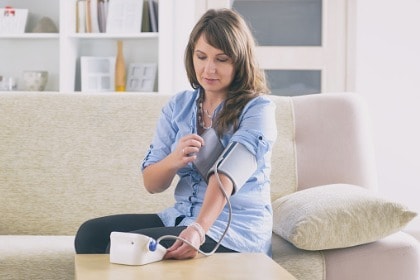6 Easy Ways to Do an Adrenal Fatigue Test at Home
In a hurry? Click here to read the Article Summary...
The American Institute of Stress estimates that nearly 80% of people nowadays regularly suffer physical symptoms of stress, which includes issues such as anxiety, chronic fatigue, and poor sleep [1]. But it just so happens that these same symptoms are also associated with a much more serious stress-induced syndrome known as adrenal fatigue that, if left to run its course, can be downright life-debilitating.
What Are the Adrenal Glands?

The adrenal glands are small glands (about the size of a large grape) that sit on top of your kidneys. They’re responsible for the production of many important hormones, one of the best-known being cortisol – oftentimes referred to as the “stress hormone.”
(As a side note, in women approaching menopause, the adrenal glands also take over production of sex hormones as the ovaries start slowing down.)
The adrenal glands are designed to function as a natural buffer for periodic stress, routinely adjusting hormone levels to maintain homeostasis (a state of balance) throughout the body.
What Is Adrenal Gland Fatigue?
The term “adrenal fatigue” is a bit misleading in that it doesn’t refer to the adrenal glands themselves wearing out. Rather, it’s a breakdown in how the adrenal glands communicate with the brain through a connection known as the hypothalamic-pituitary-adrenal (HPA) axis.
When the body is under prolonged or severe stress it can lead to a communication breakdown in the HPA axis leading to either adrenal overactivity or underactivity [2].
Is Adrenal Fatigue Real?

It’s also worth pointing out adrenal fatigue is somewhat controversial and is much more recognized in the alternative health realm than it is in allopathic (Western) medicine. As a result, official statistics on its prevalence remain somewhat elusive.
However, it’s well accepted in all types of medical practice that the heightening demands of modern-day life are causing average stress levels to go through the roof. This means it’s likely safe to surmise that adrenal fatigue is much more common than many people think – and you may even be suffering from it yourself.
But, how can you know for sure?
How to Test for Adrenal Fatigue: 6 At-Home Options
The good news is that there are a variety of simple but effective options for assessing your adrenal gland function from the comfort of your own home (though it’s always advisable to consult with a qualified physician or health practitioner if you think you’re currently suffering from a serious health condition).
The following six at-home health tests are useful tools for learning more about the health state of your body, specifically with regards to potential adrenal abnormalities.
#1 – Saliva Test
The so-called “gold standard” for testing adrenal function is to have your cortisol and DHEA (dehydroepiandrosterone) levels professionally evaluated using saliva samples that you collect throughout the course of an average day (usually at four separate intervals).

A qualified laboratory will be able to assess the varying levels of these two critical hormones in your body and determine whether your adrenal glands are functioning in a state of overactivity, under-activity, or balanced normalcy.
According to adrenal expert Dr. David Jockers, an Adrenal Saliva Test typically costs around $300 and is generally not covered by standard insurance policies. It’s still worth getting, though – just so long as the laboratory that interprets the results does so by evaluating all of the saliva samples in tandem with one another.
An accurate hormonal assessment simply can’t be done from one single saliva sample, as your collective hormonal rhythm is where the real answers are found concerning adrenal status.
Using a simple, at-home saliva testing kit like the one offered by ZRT Laboratory will allow you to collect saliva samples at your convenience and send them off to the company for a customized analysis.
What you’ll receive back from this type of adrenal fatigue test is a thorough analysis and hormonal “map” indicating the daily diurnal curve of your free cortisol levels relative to your DHEA levels. This can accurately indicate the functional status of your adrenal glands [3].
#2 – Blood Pressure
Since another primary function of the adrenal glands is to regulate blood pressure levels, testing your blood pressure levels at home can also help to give you an idea as to any potential adrenal abnormalities.

If your blood pressure levels are high, this could be a sign of adrenal hyperfunction or high stress hormones. Conversely, low blood pressure levels could indicate adrenal hypofunction, or a lack of stress hormones.
“A normal resting blood pressure should be in the range of 110-130 mm/Hg (millimeters of mercury) over 70-80 mm/Hg,” explains Dr. Jockers. “A resting blood pressure over 130/80 mm/Hg can be a sign of high adrenal output. A resting blood pressure under 110/70 mm/Hg may be a sign of low adrenal output.”
You can test your blood pressure levels at home using either a less-expensive aneroid monitor, which has a simple dial gauge that shows readings with a pointer; or a more-expensive digital monitor, which displays blood pressure levels on a digital display.
Johns Hopkins Medicine recommends avoiding coffee and cigarettes at least 30 minutes prior to taking your blood pressure for such purposes and urges at-home testers to use the bathroom first and remember to relax before performing this test [4].
#3 – Pupillary Constriction
Also known as an Iris Contraction Test, a Pupillary Constriction Test measures the contraction of the eyes’ irises in response to sudden exposure to bright light after a period of time in darkness.
First described by Dr. C.F. Arroyo back in 1924, a Pupillary Constriction Test assesses the functionality of the hypothalamic-pituitary-adrenal (HPA) axis, an interconnected system inside the body that manages stress levels via the adrenal glands.

You can perform this simple adrenal fatigue test at home by sitting in front of a mirror in a dimly lit room for a few minutes before suddenly shining a flashlight in your eyes at a roughly 45-degree angle. As you do this, your irises will naturally constrict and decrease in size. The time it takes for this to occur, as well as the process by which it occurs, can tell you a whole lot about your adrenal function.
If your irises stay constricted (small/closed) for 20 seconds or longer in response to the light, your HPA axis is likely functioning up to par. If your irises experience fasciculation (twitching) for roughly 10-20 seconds, you could have mild HPA axis disruption.
If this fasciculation lasts for just 5-10 seconds, then you might have generalized HPA axis fatigue. And if there’s an immediate pulsation and dilation of your irises (they get big and then small) in response to the light, then you could have more severe HPA axis exhaustion or failure.
#4 – Orthostatic Hypotension
Similar to the Blood Pressure Test we already covered in #2, an Orthostatic Hypotension Test involves just the use of a blood pressure cuff. After lying down and resting for five minutes, take your blood pressure and write down the results. Then stand up and immediately take your blood pressure again, also writing down the results.
According to Dr. Jockers, your systolic pressure (the top number) should naturally rise about 10 mm/Hg when you shift from the lying to the standing position. If your systolic pressure remains at the same level or decreases, this could be a sign that your adrenals are fatigued and failing to naturally release epinephrine when you stand, which they would normally do to ensure that enough blood is pumping towards your heart.
“Your doctor will diagnose orthostatic hypotension if you have a drop of 20 millimeters of mercury (mm Hg) in your systolic blood pressure or a drop of 10 mm Hg in your diastolic blood pressure within two to five minutes of standing up, or if standing causes signs and symptoms,” explains the Mayo Clinic, which also recommends this test [5].
#5 – Sargent’s White Line Test
First developed by French endocrinologist Emile Sargent, Sargent’s White Line Test is a simple way to test for moderate-to-severe adrenal hypofunction at home [6]. It’s said to be about 40% effective in revealing the presence of adrenal fatigue and can be done at no cost using a pointy, but not sharp, object such as the dull end of a retracted ballpoint pen.

To perform this test effectively, first uncover your abdomen and expose it to natural light for 15 minutes. Then, take your pointy object and gently and lightly stroke a patch of skin back and forth, creating a roughly six-inch straight line. Be sure not to scratch or break the skin in the process.
Within a few seconds, a white line should appear that, not long after that, turns red in color – this being an indicator that your adrenal glands are healthy.
If the line stays white for several minutes, however, widening but never turning red, this could suggest the presence of adrenal gland fatigue. That’s because a lack of reddening typically suggests insufficient blood pressure levels in the body, which as with the Blood Pressure Test points to adrenal output being too low.
#6 – Rogoff’s Sign
Named after Dr. Steven Rogoff, the physician who first discovered it, Rogoff’s Sign is another simple, at-home test for evaluating adrenal function.
It’s pretty self-explanatory: if you experience unrelenting pain in the midsection of your back where your ribs are located – and it never really goes away like muscle pain would – this could be a sign of underlying adrenal fatigue [7].
What to Do With Your At-Home Adrenal Test Results?
The purpose of doing an adrenal fatigue test at home is not to turn you into your own doctor, but to help you keep an eye on your own health status. Please discuss any worrisome or inconsistent findings with your primary healthcare provider to determine what actions, if any, are recommended.
Maintaining Healthy Adrenals Through Diet & Lifestyle
Keep in mind that your overall adrenal health is dependent upon you maintaining a proper electrolyte balance within your body – particularly a balanced ratio of sodium and potassium.
Trace minerals, full-spectrum sea and earth salts, and mineral-rich foods – not to mention plenty of clean water and rest – are all necessary for keeping your adrenal glands fully charged, adequately hydrated, and ready to go at all times.
Some additional health & lifestyle approaches that can help to keep your adrenals fit as a fiddle include:
- supplementing with vitamins and other minerals such as magnesium [8]
- maintaining an anti-inflammatory diet
- avoiding caffeine and sugar
- skipping foods that trigger gut problems and sensitivities
- exposing your skin to natural sunlight
- exercising regularly
- using essential oils
- turning off your phone and other electronic devices at least one hour before winding down and going to sleep at night
Magnesium deficiency is linked to stress, diabetes, heart disease, osteoporosis, chronic fatigue syndrome, depression, anxiety, trouble sleeping, sore muscles, migraines, and many more debilitating health conditions.
If your body needs magnesium, you want the most beneficial kind your body can actually absorb. New Organixx Magnesium 7 gives you seven (7) of the very best, most bioavailable types of elemental magnesium available.

 Sources:
Sources:
Article Summary
The adrenal glands are responsible for the production of many important hormones, including cortisol – oftentimes referred to as the “stress hormone.”
The adrenal glands are designed to adjust hormone levels to maintain homeostasis (a state of balance) throughout the body.
Adrenal fatigue is a breakdown in how the adrenal glands communicate with the brain through a connection known as the hypothalamic-pituitary-adrenal (HPA) axis.
There are a variety of simple but effective options for assessing your adrenal gland function from the comfort of your own home. Six tests you can do from home are:
- Saliva Test
- Blood Pressure
- Pupillary Constriction
- Orthostatic Hypotension
- Sargent’s White Line Test
- Rogoff’s Sign
See the article for details on how each test is performed
There are a number of health & lifestyle approaches that can help to keep your adrenals functioning well.



Very interesting article. Is there a way to obtain a copy please?
Sure thing, Peter!
We just sent you a pdf copy of this article that you may read on your gadgets anytime and anywhere. You may also print yourself a physical copy of this article.
Thank you so much for tuning in. Wishing you a lovely day!
Send articles
Hi Ellen Galeski, thanks for your interest.
If you would like a copy of this article, all you would need to do is hit (ctrl) (P) on your computer and it will give you the option to either print it or save it as a PDF on your computer.
We hope this helps and wish you a happy and healthy day!
Found this article informative. Would you please send me a PDF of the article. I would like to print it out for reference.
We're so happy to hear that you found this article informative, Mary Ellen. Thank you so much for your feedback.
If you would like to print this article for your keeping, all you would need to do is hit (ctrl) (P) on your computer and it will give you the option to either print it or save it as a PDF on your computer.
We hope this helps and wish you a happy and healthy day!
I was so interested, could you please sent pdf.
Hi Jan, we’re so happy to hear that you found this article informative. Thanks for your feedback.
If you would like a copy of this article, all you would need to do is click (ctrl) (P) on your computer and it will give you the option to either print it or save it as a PDF on your computer.
Hope this helps. Wishing you a lovely day!